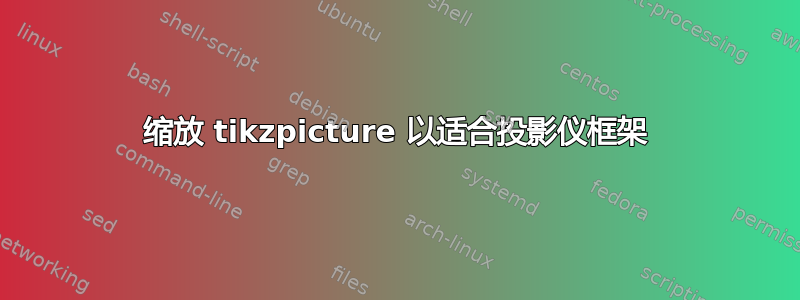
我如何垂直缩放图形以适应框架?
\begin{frame}{P\textsuperscript{H}metry studies}
\begin{figure}[scale=0.5\textheight]
\begin{tikzpicture}
\node [block] at (0,6) (GERD){GERD};
\node [block] at (-3,4) (Esophagitis){Reflux esophagitis};
\node [block] at (0,4) (NERD){NERD};
\node [block] at (3,4) (Barret){Barret's esophagitis};
\node [block] at (0,2) (Ph){Ph testing};
\node [block] at (-3,0) (positive) {Ph +ve NERD};
\node [block] at (3,0) (Negative){Functional heart burn};
\node[] at (3,-2)(Symptoms) {\footnotesize {Symptoms associated with P\textsuperscript{H} changes?}};
\node [block] at (5, -4)(hypersensitive) {hypersensitive esophagus};
\node[block] at (1,-4)(unassociated){Acid unassociated heart burn};
\begin{scope}[cyan!40!black]
\draw[->] (GERD) -- (Esophagitis);
\draw[->] (GERD) -- (NERD);
\draw[->] (GERD) -- (Barret);
\draw[->] (NERD)--(Ph);
\draw[->](Ph)--(positive);
\draw[->](Ph)--(Negative);
\draw[->](Negative)--(Symptoms);
\draw[->](Symptoms)--(unassociated);
\draw[->](Symptoms)--(hypersensitive);
\end{scope}
\end{tikzpicture}
\end{figure}
\end{frame}
答案1
一个选项是使用比例因子tikzpicture:
\documentclass{beamer}
\usepackage{tikz}
\tikzset{
invisible/.style={opacity=0},
visible on/.style={alt=#1{}{invisible}},
alt/.code args={<#1>#2#3}{%
\alt<#1>{\pgfkeysalso{#2}}{\pgfkeysalso{#3}} % \pgfkeysalso doesn't change the path
},
}
\tikzset{
block/.style = {
rectangle,
thick,
text width=6em,
align=center,
rounded corners,
draw=cyan!40!black,
fill=cyan!20,
inner ysep=10pt
}
}
\begin{document}
\begin{frame}{P\textsuperscript{H}metry studies}
\begin{figure}
\begin{tikzpicture}[scale=0.7,transform shape]
\node [block] at (0,6) (GERD){GERD};
\node [block] at (-3,4) (Esophagitis){Reflux esophagitis};
\node [block] at (0,4) (NERD){NERD};
\node [block] at (3,4) (Barret){Barret's esophagitis};
\node [block] at (0,2) (Ph){Ph testing};
\node [block] at (-3,0) (positive) {Ph +ve NERD};
\node [block] at (3,0) (Negative){Functional heart burn};
\node[] at (3,-2)(Symptoms) {\footnotesize {Symptoms associated with P\textsuperscript{H} changes?}};
\node [block] at (5, -4)(hypersensitive) {hypersensitive esophagus};
\node[block] at (1,-4)(unassociated){Acid unassociated heart burn};
\begin{scope}[cyan!40!black]
\draw[->] (GERD) -- (Esophagitis);
\draw[->] (GERD) -- (NERD);
\draw[->] (GERD) -- (Barret);
\draw[->] (NERD)--(Ph);
\draw[->](Ph)--(positive);
\draw[->](Ph)--(Negative);
\draw[->](Negative)--(Symptoms);
\draw[->](Symptoms)--(unassociated);
\draw[->](Symptoms)--(hypersensitive);
\end{scope}
\end{tikzpicture}
\end{figure}
\end{frame}
\end{document}

另一个选择是使用\resizebox:
\documentclass{beamer}
\usepackage{tikz}
\tikzset{
invisible/.style={opacity=0},
visible on/.style={alt=#1{}{invisible}},
alt/.code args={<#1>#2#3}{%
\alt<#1>{\pgfkeysalso{#2}}{\pgfkeysalso{#3}} % \pgfkeysalso doesn't change the path
},
}
\tikzset{
block/.style = {
rectangle,
thick,
text width=6em,
align=center,
rounded corners,
draw=cyan!40!black,
fill=cyan!20,
inner ysep=10pt
}
}
\begin{document}
\begin{frame}{P\textsuperscript{H}metry studies}
\begin{figure}
\resizebox{!}{.8\textheight}{%
\begin{tikzpicture}
\node [block] at (0,6) (GERD){GERD};
\node [block] at (-3,4) (Esophagitis){Reflux esophagitis};
\node [block] at (0,4) (NERD){NERD};
\node [block] at (3,4) (Barret){Barret's esophagitis};
\node [block] at (0,2) (Ph){Ph testing};
\node [block] at (-3,0) (positive) {Ph +ve NERD};
\node [block] at (3,0) (Negative){Functional heart burn};
\node[] at (3,-2)(Symptoms) {\footnotesize {Symptoms associated with P\textsuperscript{H} changes?}};
\node [block] at (5, -4)(hypersensitive) {hypersensitive esophagus};
\node[block] at (1,-4)(unassociated){Acid unassociated heart burn};
\begin{scope}[cyan!40!black]
\draw[->] (GERD) -- (Esophagitis);
\draw[->] (GERD) -- (NERD);
\draw[->] (GERD) -- (Barret);
\draw[->] (NERD)--(Ph);
\draw[->](Ph)--(positive);
\draw[->](Ph)--(Negative);
\draw[->](Negative)--(Symptoms);
\draw[->](Symptoms)--(unassociated);
\draw[->](Symptoms)--(hypersensitive);
\end{scope}
\end{tikzpicture}%
}
\end{figure}
\end{frame}
\end{document}



